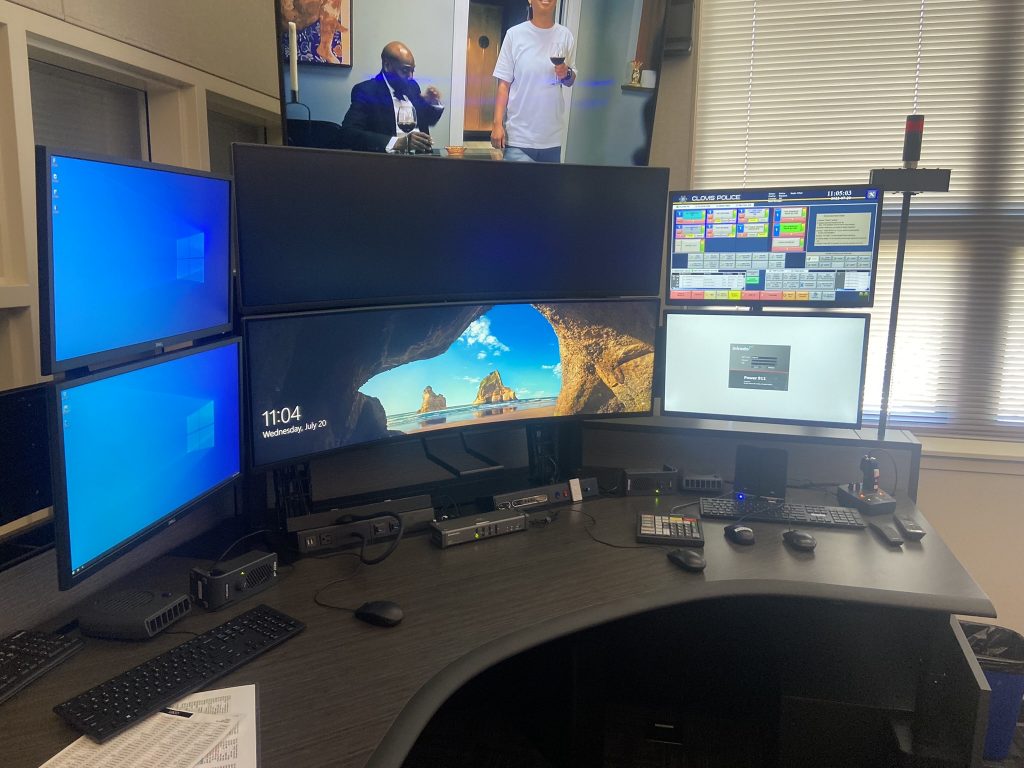
Recently, the Clovis Roundup was afforded the opportunity to observe the newly remodeled Dispatch Center at the Clovis Police Headquarters. While there, a program was chronicled that absolutely has life saving capabilities. Live911 is a third-party service that is used by both the dispatch center and officers independently of their other equipment.
The way Live911 works is simple: A live 911 call comes into the dispatch center, while simultaneously also being broadcast live into an officer’s police car. There the officer can then listen to the entire 911 call as if they were sitting in the dispatch center next to Tiffany Viau, Lead Public Safety Dispatcher.
“One of the best things about it, the officers can be logged into it and hear important information that we don’t necessarily need to give out over the air, but they can still get the info.”
The information that is so vital to officers in the field becomes a “really useful tool” that can assist in preparing officers on how they feel they need to handle a scene. For instance, if someone is in need of life saving resuscitation and a police officer is one minute closer than an EMS vehicle, that one minute could mean the difference between life or death.
Live911 also reveals the exact location of the call on a map so that officers do not have to wait for the dispatch center to call out a location or send out pertinent information. Live911’s basic uses are for police officers in the field to receive an added quicker line of communication coming straight from the caller, and saving time in life threatening situations.
According to Public Information Officer Ty Wood, when using the Live911 system, officers have had the capabilities to be on scene even before a dispatcher is able to send out a location. In the instance of Police Officer Trace Garabedian, his most recent use of Live911 gave him the capacity to stop a potential ongoing domestic violence situation.
Officer Garabedian first heard a 911 call come through his radio through the Live911 service, just at the same time as the call was making its way through to the dispatch center. Then, a location popped up on a map on the computer in his car, and he was able to map a route to the scene in which the 911 call came from. The scene Garabedian was arriving at was from a call from a neighbor of a woman who was heard screaming. Garabedian explained that he could hear the neighbor describing the situation, “They’re saying, ‘My neighbor is screaming at the top of her lungs. I think she needs help.’”
Using the location of the neighbor, the source of the 911 call, Officer Garabedian was able to arrive on scene just as the couple that was involved in the domestic violence situation was about to get in their truck and leave the scene. Officer Garabedian believes that if it weren’t for the few seconds earlier he was able to react to the Live911 call rather than wait for the call to come through from the dispatch center, the couple would have sped away, and future domestic violence acts would have occurred.
“Those couple of seconds made the difference between this guy going to jail on a felony domestic violence case or them just driving away scot-free, and that female being a constant victim of domestic violence… Just those couple of seconds today, might have saved her life.”
Officer Levi Pluss also described a scenario that involved an unresponsive elderly gentleman that required life saving resuscitation, a situation that Ty Wood explains as probably, ”…the most common type of call that benefits from the Live911 system.”
“Someone found their grandfather unresponsive and not breathing,” Officer Pluss began, “We didn’t know that he had been unconscious and not breathing for a while, but we still found signs of life and started CPR. And that guy actually ended up living and getting transported to the hospital.”
But Officer Garabedian also explained that not only does the Live911 service assist in life threatening situations, it can generally help in other 911 calls to dictate how an officer may arrive on scene. “You hear them say ‘I need help’ and when you can start hearing everything they’re saying [the caller], you can just focus on driving. Instead of hearing it from dispatch and then having to think about what’s going on. I’ll have a pretty good understanding of what’s already going on from what I heard from this person calling in.”








